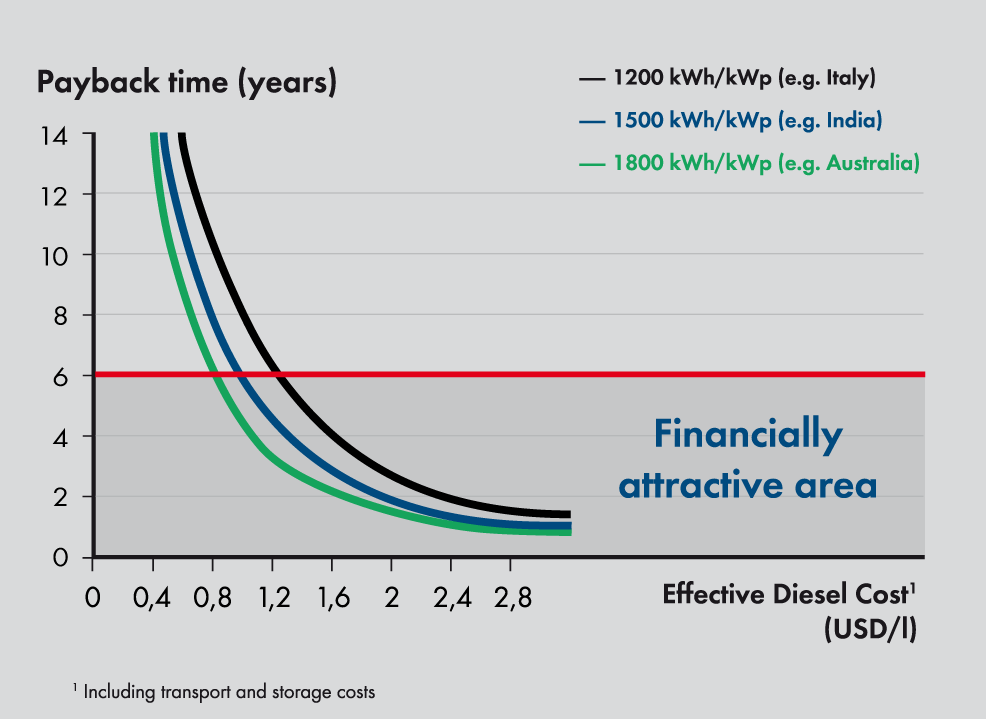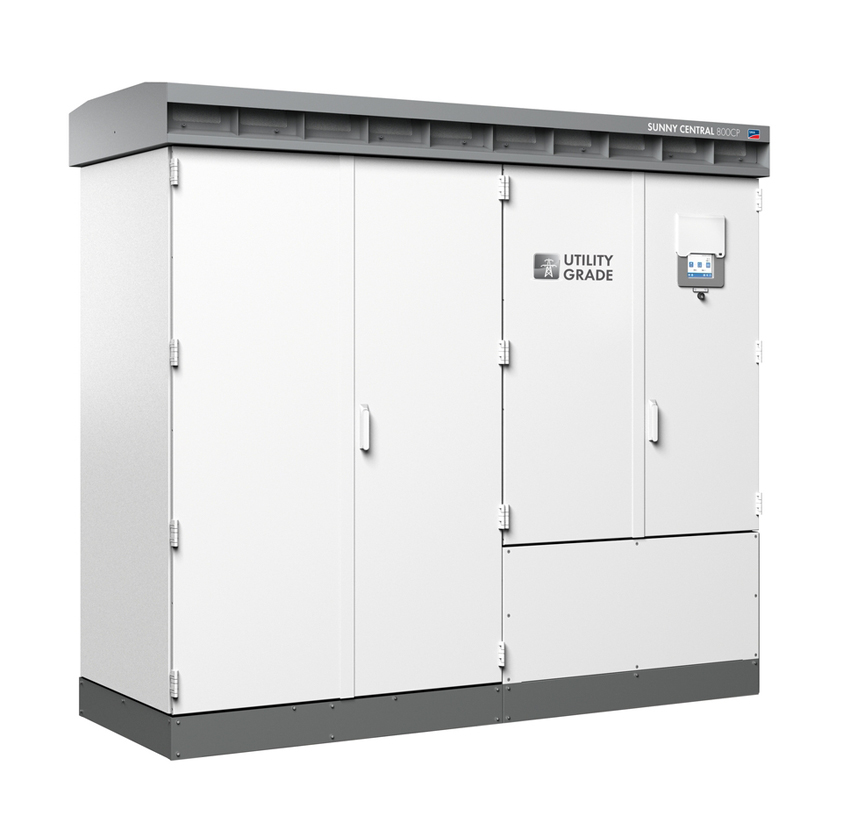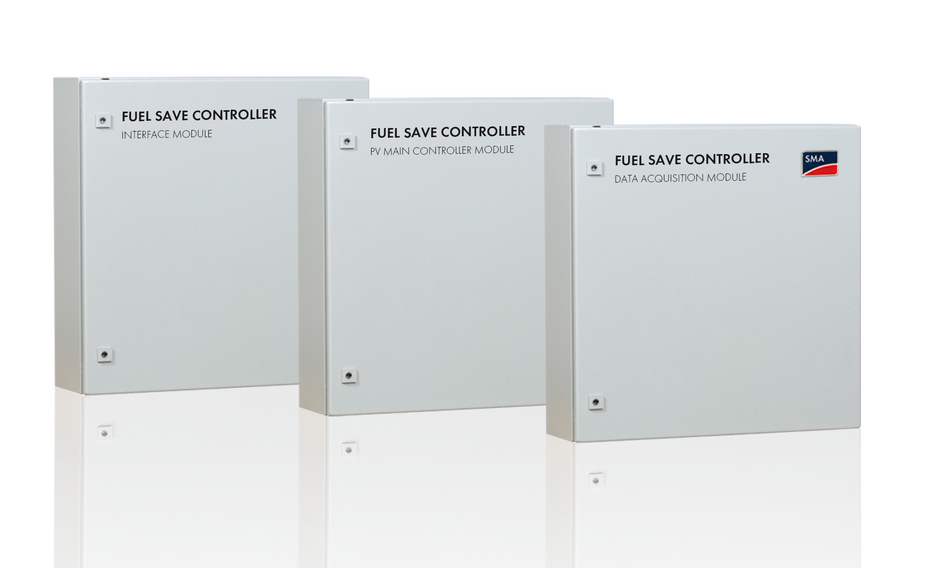PV-Diesel-Hybrid System
The Fuel Save Solution - Photovoltaic Diesel Hybrid System

 In addition, if the fuel has to be transported to remote regions, the effective costs increase even more as a result of the necessary storage. At the same time, PV system costs have dropped by more than 50 percent within the last three years: Solar power is often the most economical alternative energy source for remote regions in the world’s sun belt. It simply makes sense to combine PV and diesel systems so that solar irradiation – which is both abundant and free – can profitably be used as an energy source in industrial applications.
In addition, if the fuel has to be transported to remote regions, the effective costs increase even more as a result of the necessary storage. At the same time, PV system costs have dropped by more than 50 percent within the last three years: Solar power is often the most economical alternative energy source for remote regions in the world’s sun belt. It simply makes sense to combine PV and diesel systems so that solar irradiation – which is both abundant and free – can profitably be used as an energy source in industrial applications.
In November 2012, the first off-grid photovoltaic diesel hybrid system in the megawatts went into operation in Thabazimbi, South Africa. Using the SMA Fuel Save Solution, the system complements the existing diesel energy supply with solar energy. The operator can save up to 450,000 liters of diesel per year and significantly reduce CO2 emissions. But how does that work? And what exactly is a photovoltaic diesel hybrid system?
What is a photovoltaic diesel hybrid system?
A “hybrid” is something that is formed by combining two kinds of components that produce the same or similar results. A photovoltaic diesel hybrid system ordinarily consists of a PV system, diesel gensets and intelligent management to ensure that the amount of solar energy fed into the system exactly matches the demand at that time. In contrast to conventional off-grid systems of up to 300 kW, in which a Sunny Island inverter serves as a master, the diesel gensets itself performs this function.
How does a photovoltaic diesel hybrid system work?
Basically, the PV system complements the diesel gensets. It can supply additional energy when loads are high or relieve the genset to minimize its fuel consumption. In the future, excess energy could optionally be stored in batteries, making it possible for the hybrid system to use more solar power even at night. Intelligent management of various system components ensures optimal fuel economy and minimizes CO2 emissions.
What are the advantages of a photovoltaic diesel hybrid system?
In addition, PV systems are flexible and can be expanded on a modular basis as the energy demand grows. Compared to pure gensets systems, a photovoltaic diesel hybrid system provides numerous advantages:
- Lower fuel costs
- Reduced risk of fuel price increases and supply shortages thanks to optimized planning
- Minimal CO2 emissions (protects the environment and facilitates CO2 certificate trading)
SMA’s solution for photovoltaic diesel hybrid system technology is the SMA Fuel Save Solution. The information provided below explains how it works and you can learn other interesting facts.
What are the components of this photovoltaic diesel hybrid system?
1. PV Inverters
SMA inverters are the central components of the SMA Fuel Save Solution. Designed specifically to be used in weak utility grids, they are suitable for high voltage and frequency fluctuations. They also remain extremely productive in harsh ambient conditions such as heat, moisture, salty air, among others. Both the Sunny Tripower and the Sunny Central can be used in a photovoltaic diesel hybrid system.
2. PV array
3. SMA Fuel Save Controller
The Fuel Save Controller provides the perfect interface between the gensets, PV systems and loads, managing demand-based PV feed-in into the diesel-powered grid. As the central component of the Fuel Save Solution, it ensures maximum security with reduced fuel costs and minimizes CO2 emissions.
a.) PV Main Controller Module
Controls PV power injected into the Diesel grid. Provides optimal PV feed-in capacity by evaluating current genset and overall load status.
b.) Data Acquisition Module
Quickly and precisely analyzes the current load and grid conditions in the system and transmits the data immediately to the PV Main Controller Module.
c.) Interface Module
Mandatory in decentralized PV System structures: Records and transmits data and setpoints as the interface between PV Main Controller and Sunny Tripower inverters.
4. Diesel Genset
In grid-remote regions, pure diesel systems often provide the energy for industrial applications. They constitute the local grid, ensuring a constant power supply to all connected users. Because the gensets require a constant fuel supply, they are often the system’s highest operating cost. In regions with weak utility grids, diesel gensets often serve as a backup during grid power outages.
5. Genset system house
This includes the management and control systems for the diesel gensets. The genset system house is the central connection and coupling point.
6. Optional storage batteries
To boost the efficiency of the entire energy supply system, it is advisable to include a storage battery. Battery banks compensate for fluctuations in load and insufficient solar irradiation, providing spinning reserve and optimize diesel genset operation.
7. Industrial loads
Application specific load profiles, e.g., heavy duty industrial loads for mining or processing raw materials as well as for agricultural use or tourism facilities are generally characterized by loads with high starting currents and widely fluctuating load curves. Intelligent system management ensures that generation and load are perfectly matched. It achieves constant system stability by reacting quickly to generation and load performance spikes, e.g. when a conveyor belt is turned on.
When and where does a photovoltaic diesel hybrid system make sense?
For industrial large-scale loads in remote regions or tourism facilities like hotel resorts, complementing diesel gensets with photovoltaics is the ideal solution under the following conditions:
- When the effective cost of diesel exceeds one US dollar per liter.
- When intelligent communication between the genset and PV systems facilitates demand-oriented use of PV power.
- When local solar irradiation conditions allow the use of PV (especially economically viable with PV yields above 1,500 kWh/kWp)
Photovoltaic diesel hybrid systems can be amortized especially quickly in sunny regions, with weak or no grid access. Such innovative system technology maximizes the use of solar energy in combination with diesel aggregates which complements the PV system or is used as backup power supply. For industries such as mining; raw material processing; agricultural companies such as fish farms and water desalinization systems and tourism facilities such as hotel resorts or large holidays parks with a high energy demand, low power generation costs, quick operational readiness, maximum reliability and availability are fundamental. The environmental benefits are also convincing: CO2 emissions and noise pollution are significantly reduced, minimizing the environmental impact. Environmentally friendly and cost-effective? Yes, we can do that.



